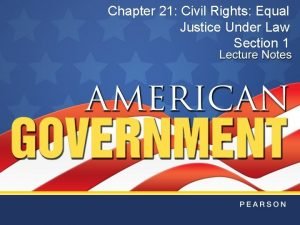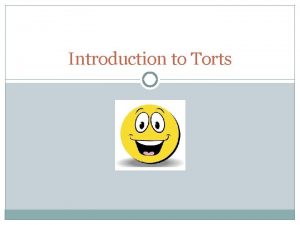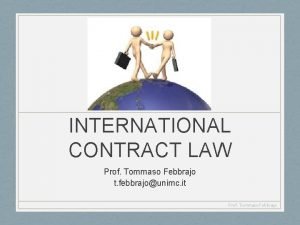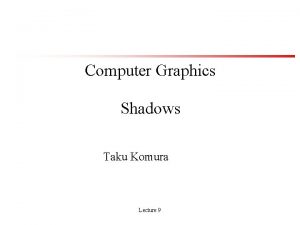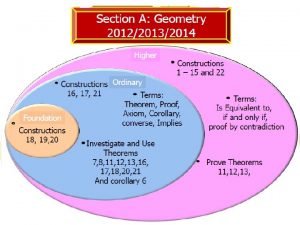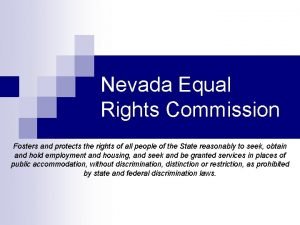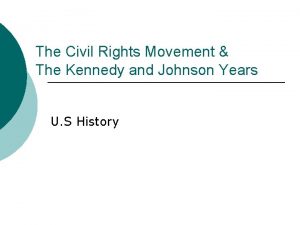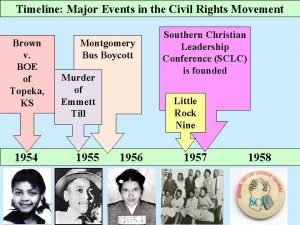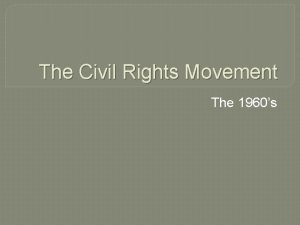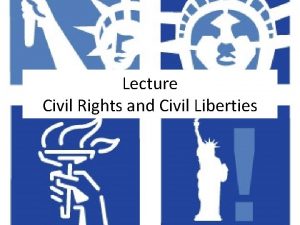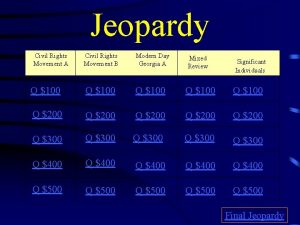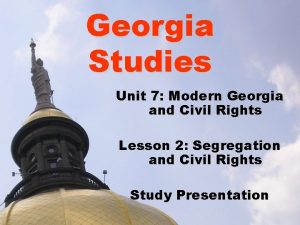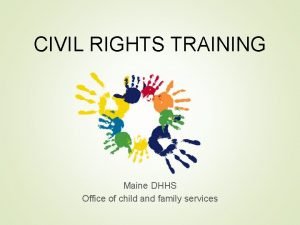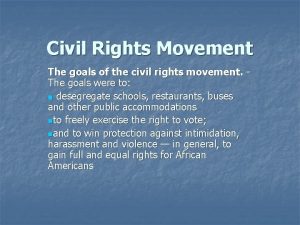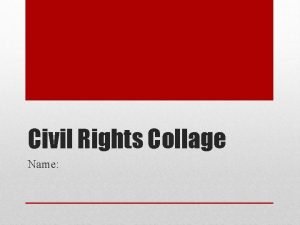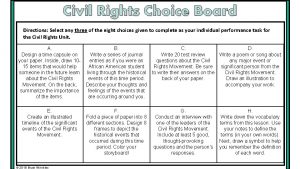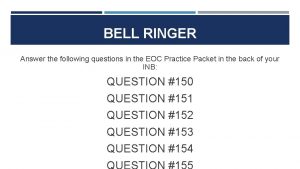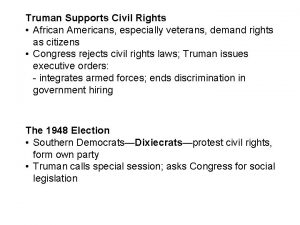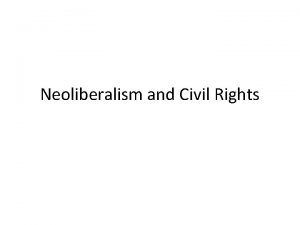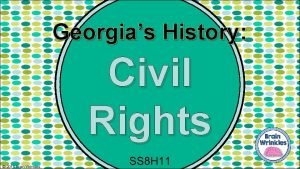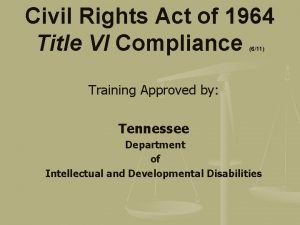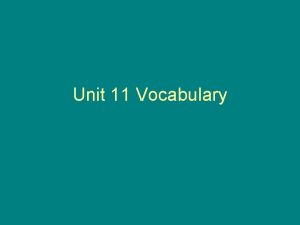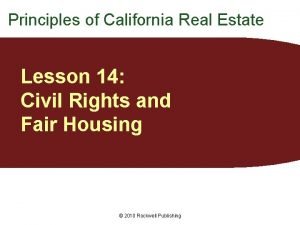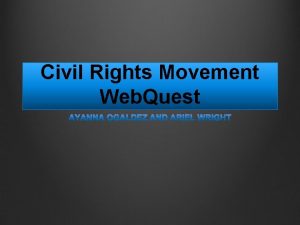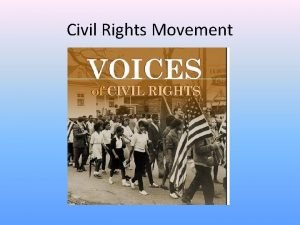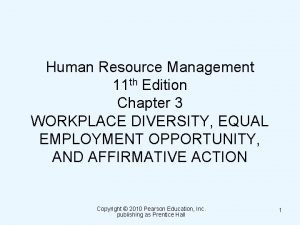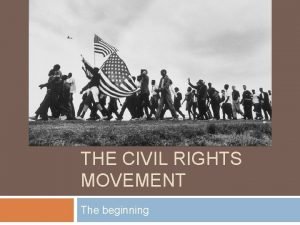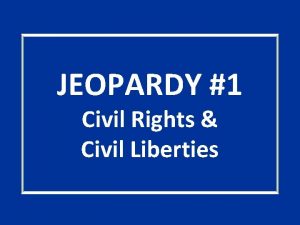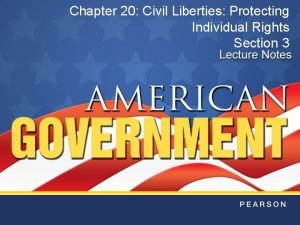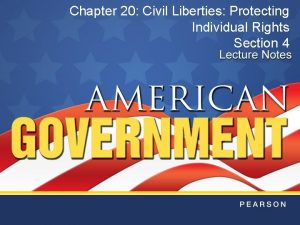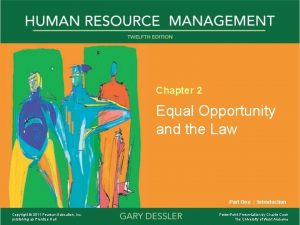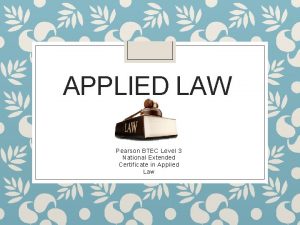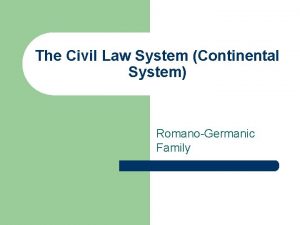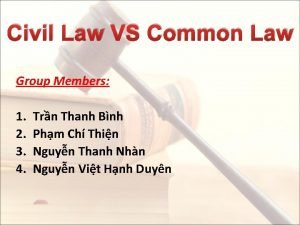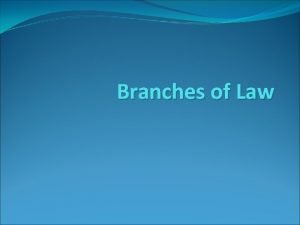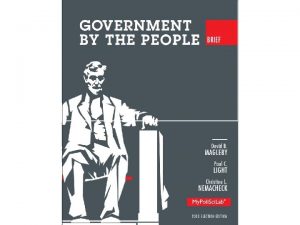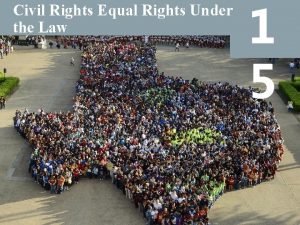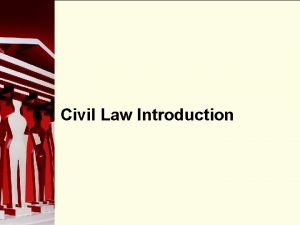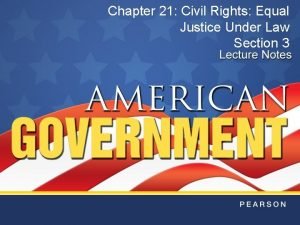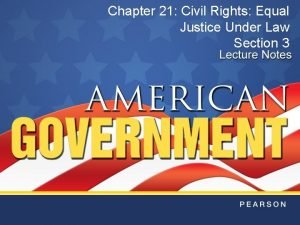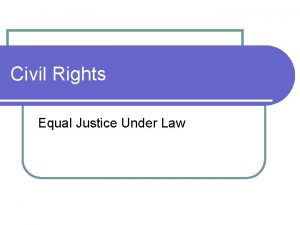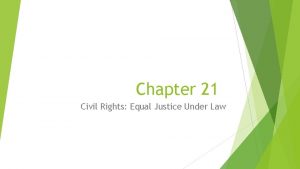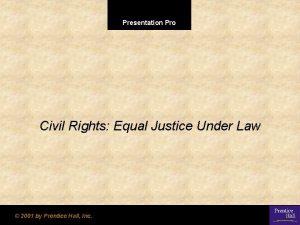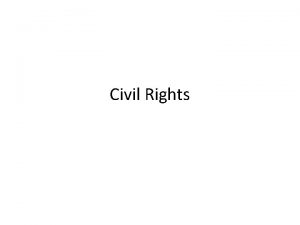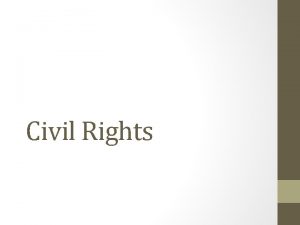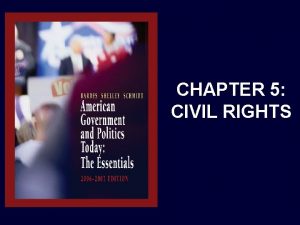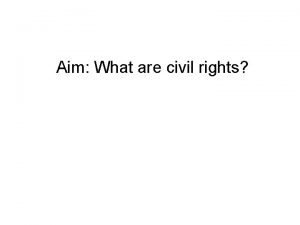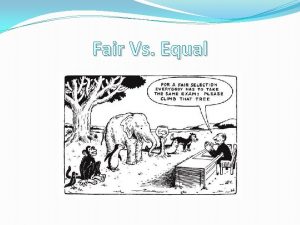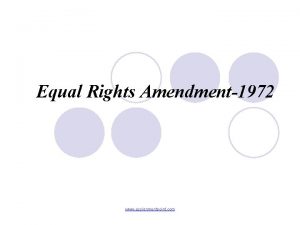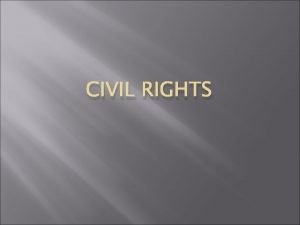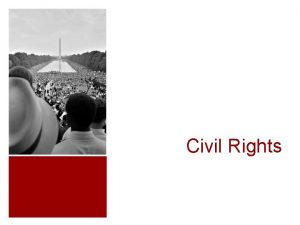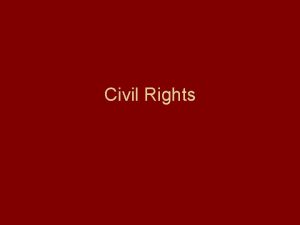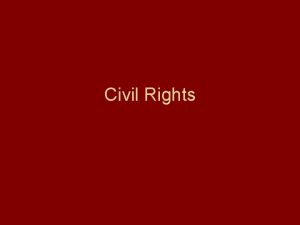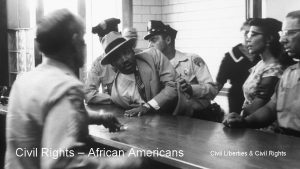Civil Rights Equal Rights Under the Law 12































































- Slides: 63


Civil Rights Equal Rights Under the Law 12

Video: The Big Picture 12 http: //media. pearsoncmg. com/ph/hss/SSA_SHARED_MEDIA_1/pol isci/presidency/Magleby. Brief_Ch 12_Civil_Rights_Seg 1_v 2. html

Learning Objectives 12 12. 1 Explain the concept of equality and assess the rights of citizens 12. 2 Compare and contrast the efforts of various groups to obtain equal protection of the law

Learning Objectives 12 12. 3 Analyze the Supreme Court’s threetiered approach used to evaluate discriminatory laws 12. 4 Trace the evolution of voting rights and analyze the protections provided by the 1965 Voting Rights Act

Learning Objectives 12 12. 5 Describe congressional legislation against discrimination in housing, employment, and accommodations 12. 6 Evaluate the historical process of school integration and the current state of affirmative action

Learning Objectives 12. 7 12 Assess the status of civil rights in the United States today

Video: The Basics 12 http: //media. pearsoncmg. com/ph/hss/SSA_SHARED_MEDIA_1/pol isci/presidency/Seg 2_Civil. Rights_v 2. html

Equality and Equal Rights ¤ How Citizenship Is Acquired and Lost ¤ Rights of U. S. Citizens ¤ Rights of Resident Aliens 12. 1

Video: In Context 12. 1 http: //media. pearsoncmg. com/ph/hss/SSA_SHARED_MEDIA_1/pol isci/presidency/Seg 3_Civil. Rights_v 2. html

How Citizenship Is Acquired and Lost ¤ Naturalization n Prior to 1865, states determined citizenship n 14 th Amendment definitions n State or federal court (as well as the U. S. Citizens and Immigration Service) can grant U. S. citizenship ¤ Dual Citizenship n Each country has its own citizenship criteria n For children of U. S. citizens born abroad 12. 1

Table 12. 1: Requirements for naturalization 12. 1

Rights of U. S. Citizens ¤ States confer most important rights n Residency requirements ¤ Rights of national citizenship n Freedoms to n travel n petition the government n vote ¤ War-time rights can be restricted n 1941 Internment of Japanese-Americans 12. 1

Japanese American citizens during World War II 12. 1

Rights of Resident Aliens ¤ Aliens may be expelled or detained ¤ Aliens enjoy fundamental freedoms n Speech, religion, due process, etc. ¤ Aliens can be denied benefits and employment 12. 1

12. 1 Which of the following can grant U. S. citizenship? a. A state court b. A federal court c. The U. S. Citizenship and Immigration Services d. All of the above 12. 1

12. 1 Which of the following can grant U. S. citizenship? a. A state court b. A federal court c. The U. S. Citizenship and Immigration Services d. All of the above 12. 1

The Quest for Equal Justice ¤ ¤ Racial Equality Women’s Rights Hispanics Native Americans 12. 2

Racial Equality ¤ Segregation and White Supremacy ¤ Slow Government Response ¤ A Turning Point 12. 2

Civil rights activists march in Selma 12. 2

Women’s Rights ¤ Suffrage movement n Seneca Falls Women’s Rights Convention n 19 th Amendment (1920) ¤ Civil Rights Act n Gains in equal pay, rights, and benefits ¤ Equal Rights Amendment (ERA) n Failed to be ratified 12. 2

FIGURE 12. 1: Percentage of Bachelor’s Degrees Awarded, by Sex 12. 2

Hispanics ¤ Historic attitudes on immigration n Often met with suspicion by natives n Obstacles included laws and customs ¤ Illegal immigration n Major policy issue for Mexico and the U. S. n Discrimination challenges to law enforcement 12. 2

Illegal Immigration 12. 2

Asian Americans 12. 2 ¤ Chinese Americans n Chinese Exclusion Act (1882) n Immigration and Nationality Act (1965) ¤ Japanese Americans n Early 20 th c. laws against owning land, attending school n Internment during WWII

Native Americans ¤ Forcibly moved to reservations n Indian Removal Act ¤ American Indian Movement ¤ Poverty and unemployment high 12. 2

12. 2 Which of the following granted women the right to vote? a. The 19 th Amendment b. The 14 th Amendment c. The Voting Rights Act d. The Civil Rights Act 12. 2

12. 2 Which of the following granted women the right to vote? a. The 19 th Amendment b. The 14 th Amendment c. The Voting Rights Act d. The Civil Rights Act 12. 2

Equal Protection of the Laws: What Does It Mean? ¤ Constitutional Classifications and Tests n n 5 th Amendment “Due process” clause 14 th Amendment “Equal protection” clause 12. 3

Constitutional Classifications and Tests 12. 3 ¤ The Rational Basis Test ¤ Suspect Classifications and Strict Scrutiny ¤ Quasi-Suspect Classifications and Heightened Scrutiny

Constitutional Classifications and Tests ¤ Poverty and Age ¤ Sexual Orientation ¤ Fundamental Rights and Strict Scrutiny 12. 3

Table 12. 2: Major Civil Rights Laws 12. 3

Same-sex marriage 12. 3

Video: In the Real World 12. 3 http: //media. pearsoncmg. com/ph/hss/SSA_SHARED_MEDIA_1/pol isci/presidency/Seg 5_Civil. Rights_v 2. html

12. 3 All the following require a governmental burden of interest EXCEPT a. Rational basis test b. Strict scrutiny test c. Quasi strict scrutiny test d. Heightened scrutiny test 12. 3

12. 3 All the following require a governmental burden of interest EXCEPT a. Rational basis test b. Strict scrutiny test c. Quasi strict scrutiny test d. Heightened scrutiny test 12. 3

Explore Civil Rights: Are All Forms of Discrimination the Same? http: //media. pearsoncmg. com/long_magleby _mpslgbp_brief 10/pex 12. html 12. 3

Voting Rights ¤ Protecting Voting Rights ¤ The Voting Rights Act of 1965 12. 4

Protecting Voting Rights 12. 4 ¤ Changes in the 1940 s n Increased African American political presence in cities n Attitudes of Roosevelt administration and Supreme Court n National Security needs ¤ Court Action n Prohibition on racial gerrymandering n 24 th Amendment: elimination of poll tax

The Voting Rights Act of 1965 12. 4 ¤ Codified Supreme Court decisions of the 1950 s n Prohibition on denial of voting rights based on race or color n Forbids threats or intimidation ¤ In areas of historical discrimination: n Federal officials monitor elections n States must get federal clearance before implementing changes to elections and districts

Gerrymandering 12. 4

12. 4 Which of the following prohibits the use of a poll tax? a. The Civil Rights Act b. The 14 th Amendment c. The “due process” clause d. The 24 th Amendment 12. 4

12. 4 Which of the following prohibits the use of a poll tax? a. The Civil Rights Act b. The 14 th Amendment c. The “due process” clause d. The 24 th Amendment 12. 4

Rights to Equal Access: Accommodations, Jobs, and Homes 12. 5 ¤ Civil Rights Act of 1964 and Places of Public Accommodation ¤ Civil Rights Act of 1964 and Employment ¤ The Fair Housing Act and Amendments

12. 5 Which of the following was used by the Supreme Court in interpreting civil rights legislation? a. The equal protection clause b. The due process clause c. The commerce clause d. The necessary and proper clause 12. 5

12. 5 Which of the following was used by the Supreme Court in interpreting civil rights legislation? a. The equal protection clause b. The due process clause c. The commerce clause d. The necessary and proper clause 12. 5

Education Rights 12. 6 ¤ The End of “Separate but Equal”: Brown v. Board of Education ¤ From Segregation to Desegregation—But Not Yet Integration ¤ The Affirmative Action Controversy ¤ Reaffirming the Importance of Diversity

The End of “Separate but Equal”: Brown v. Board of Education ¤ Brown v. the Board of Education (1954) n Decision based on 14 th Amendment n Instigated school desegregation ¤ Title VI enforcement n authority to withhold all federal funding to schools, school districts, or states practicing discrimination 12. 6

From Segregation to Desegregation—But Not yet Integration 12. 6 ¤ Court-ordered busing ¤ De jure vs. de facto segregation ¤ 1990 s: Return of school controls to States

Brown v. Board of Education 12. 6

The Affirmative Action Controversy 12. 6 ¤ Affirmative action programs n Target consequences of discrimination n Extremely controversial ¤ University of California Regents v. Bakke (1978) n Supreme Court finds racial quotas to be unconstitutional

Reaffirming the Importance of Diversity 12. 6 ¤ 2003 re-affirmation of Bakke ¤ Voter initiative against affirmative action programs n Several states abolished affirmative action ¤ Pending cases for Supreme Court involve affirmative action questions

Affirmative Action 12. 6

Video: Thinking Like a Political Scientist http: //media. pearsoncmg. com/ph/hss/SSA_SHARED_ MEDIA_1/polisci/presidency/Seg 4_Civil. Rights_v 2. html 12. 6

12. 6 Which of the following 12. 6 challenged the segregation of schools? a. Brown v the Board of Education b. University of California Regents v. Bakke c. Plessy v. Ferguson d. Marbury v. Madison

12. 6 Which of the following 12. 6 challenged the segregation of schools? a. Brown v the Board of Education b. University of California Regents v. Bakke c. Plessy v. Ferguson d. Marbury v. Madison

Equal Rights Today ¤ Victories helped middle class ¤ Discrimination still exists for poor n Minorities live in poorer neighborhoods than whites ¤ Need to focus on socio-economic class differences today 12. 7

12. 7 Which group benefits least from increases in civil rights protection? a. Women b. The middle-class c. The poor d. The handicapped 12. 7

12. 7 Which group benefits least from increases in civil rights protection? a. Women b. The middle-class c. The poor d. The handicapped 12. 7

Explore the Simulation: You Are a Mayor http: //media. pearsoncmg. com/long_longman_media_1 /2013_mpsl_sim/simulation. html? simula. URL=6 12. 7

Discussion Question How have recent changes in civil rights, such as marriage laws, changed society? How have they affected your life? 12

Video: So What? 12 http: //media. pearsoncmg. com/ph/hss/SSA_SHARED_MEDIA_1/pol isci/presidency/Magleby. Brief_Ch 12_Civil_Rights_Seg 6_v 2. html

Further Review: On My. Poli. Sci. Lab ¤Listen to the Chapter ¤Study and Review the Flashcards ¤Study and Review the Practice Tests 12
 Chapter 21 civil rights equal justice under law
Chapter 21 civil rights equal justice under law Civil rights webquest
Civil rights webquest Difference between civil law and criminal law
Difference between civil law and criminal law Criminal law plaintiff
Criminal law plaintiff Common law and civil law
Common law and civil law Examples of civil law
Examples of civil law International contracts
International contracts Equal height equal light
Equal height equal light Taku graphics
Taku graphics Is equal sharing or equal grouping
Is equal sharing or equal grouping Vert. opp. ∠s equal
Vert. opp. ∠s equal Meridionalnet
Meridionalnet Kara jenkins nevada
Kara jenkins nevada Deficit spending
Deficit spending Civil rights timeline of events
Civil rights timeline of events Civil rights sitins
Civil rights sitins Rosa parks mother
Rosa parks mother Civil rights act of 1957 apush
Civil rights act of 1957 apush Right to die
Right to die Civil rights movement jeopardy
Civil rights movement jeopardy Unit 7 modern ga and civil rights
Unit 7 modern ga and civil rights Usda civil rights training
Usda civil rights training Civil rights training certificate
Civil rights training certificate Civil rights movement goal
Civil rights movement goal Civil rights in child nutrition programs
Civil rights in child nutrition programs Civil rights graphic organizer
Civil rights graphic organizer Civil rights leaders collage
Civil rights leaders collage Civil rights choice board
Civil rights choice board Chapter 20 civil liberties protecting individual rights
Chapter 20 civil liberties protecting individual rights Civil rights bell ringers
Civil rights bell ringers Truman supports civil rights
Truman supports civil rights Characteristics of civil rights
Characteristics of civil rights Civil rights cloze notes 1
Civil rights cloze notes 1 2015 brain wrinkles answer key
2015 brain wrinkles answer key Civil rights training quiz answers
Civil rights training quiz answers Title vi of the civil rights act of 1964
Title vi of the civil rights act of 1964 Civil rights in child nutrition programs
Civil rights in child nutrition programs Civil rights movement vocabulary
Civil rights movement vocabulary Unruh civil rights act real estate
Unruh civil rights act real estate Civil rights movement webquest
Civil rights movement webquest Civil rights movment
Civil rights movment Cacfp civil rights
Cacfp civil rights Title vii of the civil rights act
Title vii of the civil rights act Title vii of the civil rights act
Title vii of the civil rights act The civil rights movement
The civil rights movement Civil rights jeopardy
Civil rights jeopardy Civil rights movement essential questions
Civil rights movement essential questions Chapter 14 postwar prosperity and civil rights
Chapter 14 postwar prosperity and civil rights What did the civil rights act of 1875 do
What did the civil rights act of 1875 do Chapter 20 civil liberties protecting individual rights
Chapter 20 civil liberties protecting individual rights Chapter 20 civil liberties protecting individual rights
Chapter 20 civil liberties protecting individual rights Newton's first law and second law and third law
Newton's first law and second law and third law Newton's first law of motion
Newton's first law of motion V=k/p
V=k/p Avogadro's law constant
Avogadro's law constant Equal opportunity and the law chapter 2
Equal opportunity and the law chapter 2 Body of civil law
Body of civil law Unit 1 dispute solving in civil law
Unit 1 dispute solving in civil law Florida civil law notary
Florida civil law notary Roman law
Roman law Continental law
Continental law Difference between civil and criminal law table
Difference between civil and criminal law table Romano germanic family
Romano germanic family Difference between civil and criminal law table
Difference between civil and criminal law table
